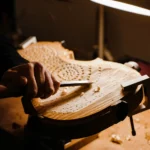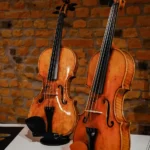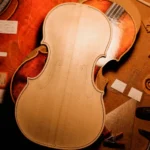What’s the Difference Between a Stradivarius, Guarneri, and Amatise Violin?
Back to BlogWhether you’re a musician looking for a new violin or someone who just wants to expand their knowledge about the stringed instrument, the topic about violin models will be a very interesting one! That’s exactly what we will be talking about; let’s explore the great master’s models and see what makes each of them unique.
The Great Masters: Stradivarius, Guarneri, and Amatise
During the time period between the 16th and early 17th centuries, The Amati, Guarneri, and Stradivari families had an important role in the violin-making scene in Cremona, and they were the ones responsible for shaping the modern violin. As it turns out, the violin has been around for a long time: “A four-string instrument was standardized during this time as a four-sided instrument with its signature shape and size, strung in perfect fifths.”
If you are acquainted with the violin, you probably noticed that Stradivari violins do not just sound different but also have a special look that differs from a Guarneri or an Amati model. They are clearly instruments of the same family; their designs, string counts, and shapes are uncannily similar. But looking carefully, we’ll see the differences.
The Amatise
The violins of Nicolò Amati (1596–1684), the pre-eminent violin maker of the Amati family, were known for their elegant design, responsiveness, and sweet sound. Famine and disease wiped out the top violin makers in Cremona, Italy, around 1630; but Amati single-handedly carried on the tradition of fine violin making. Which makes violins from that period of time so rare.
Andrea Guarneri, Giovanni Battista Rogeri, Antonio Stradivari and others were students of Amati. He seems to build his violins on a single size: the same full-size pattern, with a back length of 350mm. This is quite rare among his ‘Grand Pattern’ violins; they were generally 355mm in length, but more notably, they show much more breadth across the lower bouts, which are typically around 7 millimeters wider.
Amati’s workmanship was the best of all Cremonese makers in terms of precision and elegance. The purfling is slender with dark-stained blacks, and it is set quite close to the edges. The corners are especially long, with noticeable “hooks” on the inner edges. The varnish colors of Nicolo vary from deep orange-red to transparent golden amber, as evident on the ‘Spagnoletti’. And the scroll is gracefully carved, the chamfers are narrow and the eyes are small.
Guarneri Violin
Although not as revered as the works of Stradivari, another Italian violin maker known as Giuseppe Guarneri del Gesù produced instruments that musicians and violin enthusiasts equally treasured. One very particular characteristic of his work was the rougher design, much more adventurous with a great expression of artistic and experimental nature.
A result of his inspirations from the Brescian models. The outline of his violins is found on the instruments of Antonio Stradivari. Modeling of the back and table are noticeably flattened, seemingly inspired by Maggini.
His designs incorporate rugged character and finish, shortened body length, shallow fluting, use of a thicker backplate, elongated, uneven f-holes where the bass f-hole is often higher than the treble, hook-like corners, and erratically colored varnishes.
According to Tarisio website, His independently-produced instruments are known from the 1720s, but his signature IHS (Iesus Hominem Salvator) label didn’t appear until 1731.
One could say that Guarneri’s daring and creativity in design were why his workmanship lacked in detail.
Stradivarius Violin
Stradivari and Guarneri’s violins differ in their tonal quality, like red or white wine. The Stradivari’s sound is described as more “direct and precise,” responding to the slightest touch with refined direction and elegance, much like a high-performance sports car. Antonio Stradivari, an Italian craftsman, born in the 17th century, is widely known for his violins. Though details of his early life are scant, one theory suggests that he began working with Cremonese luthier Nicolò Amati when he was a teenager.
Who hasn’t heard about a Stradivari Violin? The most famous violin maker of all time, and for a reason! The exceptional shape of Stradivarius violins, with their sharper corners, lack of roundness, and definition between upper and lower half, set them apart from other violins.
During these years, Stradivari made two notable changes to his design—a “Long Strad” and a darker varnish. These refinements may have helped produce the exceptional sound projection and resonance associated with Stradivarius instruments, especially in nineteenth-century performances, when orchestral music moved from the drawing-room to the concert hall.
All three models are exceptional and used as inspiration by luthiers nowadays. Their work is unquestionably good, and despite these differences, in our opinion, there’s no better model, but each perfect in its own way. After all, these instruments survived centuries and still are in the hands of violinists!









